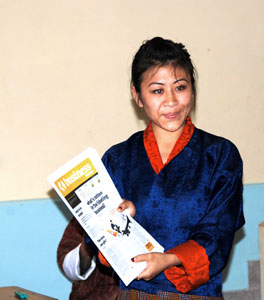Students learn journalism tricks
While many of their friends screamed out their hearts practicing for an upcoming talent show, 35 odd students sat wide-eyed listening to behind-the-scenes stories of newspaper journalism.
Adding to the heat of a spring afternoon in Paro last Saturday, Yoserling Higher Secondary School got a feel of news gathering and writing as a bunch of journalists shared stories, brain-stormed article ideas, and practiced sentences following the ‘don’t tell, show’ rule.
The program was jointly organized by the school and Business Bhutan as part of the paper’s School Bhutan program, aimed at encouraging media literacy.
 The program which started with the launch of the newspaper in September last year helps students to research, observe, and write on events happening in and around their school in a news article style. A whole broad-sheet color page is devoted to each school, where students conduct survey analysis, take photographs, interview people and write editorials and news stories. The School Bhutan page resembles the front page of the main Business Bhutan front page; thereby students can take pride in writing for a national newspaper.
The program which started with the launch of the newspaper in September last year helps students to research, observe, and write on events happening in and around their school in a news article style. A whole broad-sheet color page is devoted to each school, where students conduct survey analysis, take photographs, interview people and write editorials and news stories. The School Bhutan page resembles the front page of the main Business Bhutan front page; thereby students can take pride in writing for a national newspaper.
Schools from across the country have already been featured in the page. The Saturday program at Yoezerling launched the second phase of the project where the Business Bhutan team interacted with students face to face.
One of the main features of the three-hour program was a segment where the school principal, Chencho Tshering, was on the interview hotseat as students shot questions.
“Why does our school logo have yellow and blue, why not other colors?” asked a student.
And the principal answered “The yellow color on the outer depicts religion and we would like to have qualities of a lama in our students and the blue stands for the vastness of the universe.”
More questions related to the birth of the school followed. The interview with principal was a part of an exercise where students got five minutes to write the first sentence of an article about the school.
Going beyond a boring afternoon lecture session, students read out their sentences, which the journalists’ team analyzed, and helped students ask relevant questions that would make their writing attractive.
“I never thought that our school logo was decided over the cups of hot water, said Thinley Dorji, a student, after the mock interview.
The session began with a brief introduction of Bhutanese media from a time when Kuensel was the only paper in the country.
“Apart from informing the nation, such initiatives are part of the paper’s social responsibility,” said Business Bhutan Editor Tashi Dorji, who led the team of journalists at the session.
“Some students’ regretted not signing up for the workshop, once they heard from their friends,” said Sherab Dema of the school’s English Department who coordinated the event.
“The session was inspiring and I fancy becoming a reporter too,” “said Kezang Wangmo, a commerce student.
The session also discussed how a newspaper works.
“How does a reporter get an idea?” was one question that intrigued most students.
To illustrate how it works, students were asked to share on a topic on which they would like to write about.
The topics included increasing crime rate in Paro, Police-Youth Partnership, youth unemployment, working students and job market challenges.
The topics where then discussed and sorted as a news article or an opinion piece. The session also shared how a general idea like ‘youth unemployment’ can be narrowed down to a specific newspaper article idea like “when employers ask job experience from Class XII graduates.”
The team also shared with the students on how to collect information for an article and the process through which an article goes: from the article idea, background information, interviews, and on how to bring in life and color to writing.
The students who participated in the event will use the techniques learnt to write articles based on school activities and the local community.
The principal said the tips on writing were really helpful.
“I have started using it in my writing,” he added.
Tashi Dorji said the session was also a learning experience for the Business Bhutan team.
“The Yoserling experience will help Business Bhutan to refine our media education program plans for schools,” he said adding that the newspaper team will always be available for schools interested to conduct similar programs.
Meanwhile the communications and education ministry has developed a media literacy curriculum which will be introduced as a pilot program in five schools across the country.
By Saraswati in Business Bhutan, March 27, 2010

